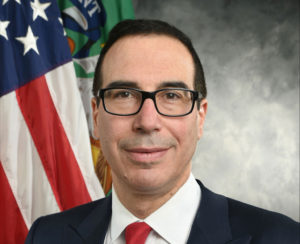
The U.S. Treasury announced Monday it approved 14 neighborhoods on St. Thomas and St. Croix as Qualified Opportunity Zones eligible for U.S. tax breaks under the massive tax bill passed by Congress last December.
A statement from Treasury quotes U.S. Treasury Secretary Steven Mnuchin saying President Donald Trump’s administration”will continue working with states and the private sector to encourage investment and development in opportunity zones and other economically disadvantaged areas and boost economic growth and job creation.”
Gov. Kenneth Mapp (I-VI) hailed the news, saying it would be good for the V.I. economy.
“These new incentives can help us attract new investments in hotel development, retail businesses and industry in our most underserved communities and can also help those looking to rebuild after the hurricanes,” Mapp said in a statement from Government House.
Mapp commended Sen. Tim Scott (R-SC) for his leadership in developing the opportunity zone legislation and spearheading it through the Congressional process. The original proposal did not include the Virgin Islands or other U.S. Territories.
According to Mapp, Scott agreed to expand the scope of eligible zones to include low-income communities in the territories after the two met and discussed it.
Qualified opportunity zones retain this designation for 10 years. Investors can defer tax on any prior gains until the end of 2026, so long as the gain is reinvested in a Qualified Opportunity Fund, an investment vehicle organized to make investments in Qualified Opportunity Zones. If the investor holds the investment in the fund for at least 10 years, the investor would be eligible for an increase in its basis equal to the fair market value of the investment on the date that it is sold. according to Treasury.
By statute, these tax break zones are limited to designated “low-income communities” in states and territories which meet certain criteria. Mapp nominated Christiansted and all of the western end of St. Croix, as well as most of the southern half of St. Thomas.
An earlier statement from Government House gave the following example of how these new tax breaks work:
Take a U.S. company that invested $10 million in a stock and sells that stock in 2018 for $20 million. Ordinarily, the $10 million gain would be subject to federal capital gains tax in 2018. If, however, within 180 days of selling the stock the company invests the $20 million in a tax break zone it obtains three significant benefits.
First, it defers payment of federal capital gains tax on the $10 million gain until the earlier of the date it sells its investment in the tax-break zone or Dec. 31, 2026.
Second, it receives a 10 percent reduction in federal capital gains tax if it holds the investment in the tax break zone for at least five years, and an additional five percent reduction if it holds the investment for at least seven years.
Third, it avoids federal capital gains tax altogether on any further appreciation in its investment in the tax break zone.
That is, if the company ultimately sells its investment in the tax break zone for $35 million after seven years – a gain of $25 million – it will defer capital gains tax on the original $10 million gain until the date of the sale, reduce the amount of that capital gain by 15 percent, and pay no capital gains tax at all on the $15 million appreciated gain.
There is a long history of Congress encouraging the territories to try to spur development with tax breaks. These new tax breaks join the 90 to 100 percent breaks on corporate income tax, gross receipts tax, property tax and excise tax the territory gives through the Economic Development Commission and through the University of the Virgin Islands Research and Technology Park.
In 2016, Mapp proposed a plan to boost the economy over five years, which relied heavily on hopes of massive growth in the number of entities taking advantage of the territory’s tax break programs.
The U.S. Virgin Islands were among 18 states and territories approved in what the Treasury Department termed the “first round” of approved tax break zones. The others were: American Samoa; Arizona; California; Colorado; Georgia; Idaho; Kentucky; Michigan; Mississippi; Nebraska; New Jersey; Oklahoma; Puerto Rico; South Carolina; South Dakota; Vermont; and Wisconsin.





